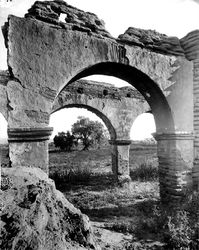Mission San Luis Rey de Francia/Gallery: Difference between revisions
imported>Robert A. Estremo (Created page with "{{subpages}} <gallery perrow=3 widths=300px heights=250px> Image:Fr. Antonio Peyri Departing - 1832.jpeg|{{Fr. Antonio Peyri Departing - 1832.jpeg/credit}}<br />Fr. Antonio Peyr...") |
imported>Robert A. Estremo mNo edit summary |
||
| Line 7: | Line 7: | ||
Image:Interior of Mission San Luis Rey de Francia circa 1893.jpg|{{Interior of Mission San Luis Rey de Francia circa 1893.jpg/credit}}<br/>The interior of Mission San Luis Rey de Francia before restoration, ''circa'' 1893. | Image:Interior of Mission San Luis Rey de Francia circa 1893.jpg|{{Interior of Mission San Luis Rey de Francia circa 1893.jpg/credit}}<br/>The interior of Mission San Luis Rey de Francia before restoration, ''circa'' 1893. | ||
Image:San Luis Rey de Francia circa 1900 Keystone-Mast Company.jpg|{{San Luis Rey de Francia circa 1900 Keystone-Mast Company.jpg/credit}}<br/>Inside the "cavernous" ''capilla'' (chapel) at Mission San Luís Rey de Francia, ''circa'' 1900. Dedicated in 1815, the cruciform design is shared only with the ruined "Great Stone Church" at [[Mission San Juan Capistrano]], making the two structures unique among the Alta California missions in that regard.<ref>Krell, pp. 154, 275</ref> | Image:San Luis Rey de Francia circa 1900 Keystone-Mast Company.jpg|{{San Luis Rey de Francia circa 1900 Keystone-Mast Company.jpg/credit}}<br/>Inside the "cavernous" ''capilla'' (chapel) at Mission San Luís Rey de Francia, ''circa'' 1900. Dedicated in 1815, the cruciform design is shared only with the ruined "Great Stone Church" at [[Mission San Juan Capistrano]], making the two structures unique among the Alta California missions in that regard.<ref>Krell, pp. 154, 275</ref> | ||
Image:CHS-2097.jpg|{{CHS-2097.jpg/credit}}<br/>Mission San Luis Rey de Francia is home to with the first Peruvian Pepper Tree (''[[Schinus molle]]'') planted in California in 1830, visible at right behind the arches in the above photograph (taken ''circa'' 1900). | |||
Image:San Luis Rey de Francia circa 1910 William Amos Haines.jpg|{{San Luis Rey de Francia circa 1910 William Amos Haines.jpg/credit}}Mission San Luis Rey de Francia, ''circa'' 1910. | Image:San Luis Rey de Francia circa 1910 William Amos Haines.jpg|{{San Luis Rey de Francia circa 1910 William Amos Haines.jpg/credit}}Mission San Luis Rey de Francia, ''circa'' 1910. | ||
Image:Choir missals at Mission San Luis Rey.jpg|{{Choir missals at Mission San Luis Rey.jpg/credit}}<br/>Illuminated choir missals on display at Mission San Luis Rey de Francia in 1913.<ref>James, p. 215</ref> | Image:Choir missals at Mission San Luis Rey.jpg|{{Choir missals at Mission San Luis Rey.jpg/credit}}<br/>Illuminated choir missals on display at Mission San Luis Rey de Francia in 1913.<ref>James, p. 215</ref> | ||
Revision as of 14:51, 2 November 2012
(PD) Drawing: Eugene Duflot de Mofras
In 1841, French explorer Eugene Duflot de Mofras produced a sketch of the Mission that depicted a second campanario, thereby supporting the theory that two bell towers were planned, but never completed; the lone tower was also used as a lookout post.[1](PD) Photo: Keystone-Mast Company
Inside the "cavernous" capilla (chapel) at Mission San Luís Rey de Francia, circa 1900. Dedicated in 1815, the cruciform design is shared only with the ruined "Great Stone Church" at Mission San Juan Capistrano, making the two structures unique among the Alta California missions in that regard.[2](PD) Photo: Charles C. Pierce
Mission San Luis Rey de Francia is home to with the first Peruvian Pepper Tree (Schinus molle) planted in California in 1830, visible at right behind the arches in the above photograph (taken circa 1900).(PD) Photo: George Wharton James
Illuminated choir missals on display at Mission San Luis Rey de Francia in 1913.[3](PD) Photo: Dick Markell / United States Navy
USNS Mission San Luis Rey (T-AO-128) was the eighteenth of twenty-seven Mission Buenaventura-class fleet oilers built during World War II for service in the United States Navy. Scrapped in 1972, she was the only U.S. Naval vessel to bear the name.[4]


![(PD) Drawing: Eugene Duflot de Mofras In 1841, French explorer Eugene Duflot de Mofras produced a sketch of the Mission that depicted a second campanario, thereby supporting the theory that two bell towers were planned, but never completed; the lone tower was also used as a lookout post.[1]](/wiki/images/thumb/0/0c/1844_Mission_San_Luis_Rey_de_Francia.jpg/300px-1844_Mission_San_Luis_Rey_de_Francia.jpg)

![(PD) Photo: Keystone-Mast Company Inside the "cavernous" capilla (chapel) at Mission San Luís Rey de Francia, circa 1900. Dedicated in 1815, the cruciform design is shared only with the ruined "Great Stone Church" at Mission San Juan Capistrano, making the two structures unique among the Alta California missions in that regard.[2]](/wiki/images/thumb/3/30/San_Luis_Rey_de_Francia_circa_1900_Keystone-Mast_Company.jpg/238px-San_Luis_Rey_de_Francia_circa_1900_Keystone-Mast_Company.jpg)


![(PD) Photo: George Wharton James Illuminated choir missals on display at Mission San Luis Rey de Francia in 1913.[3]](/wiki/images/thumb/7/7b/Choir_missals_at_Mission_San_Luis_Rey.jpg/300px-Choir_missals_at_Mission_San_Luis_Rey.jpg)
![(PD) Photo: Dick Markell / United States Navy USNS Mission San Luis Rey (T-AO-128) was the eighteenth of twenty-seven Mission Buenaventura-class fleet oilers built during World War II for service in the United States Navy. Scrapped in 1972, she was the only U.S. Naval vessel to bear the name.[4]](/wiki/images/thumb/f/f4/USNS_Mission_San_Luis_Rey.jpg/300px-USNS_Mission_San_Luis_Rey.jpg)